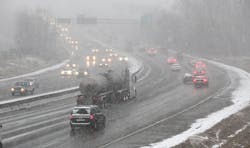As yet another winter storm barreled across the Midwest over the weekend and into the Northeast today, dumping up to a foot of snow on a region that received as much as 30 in. just last week, trucking companies are once again left to navigate their trucks over snow-covered roads in the hopes that related delays won’t disrupt customer service.
Because winter storms and other related weather events can have a significant impact on the supply chain, sometimes a “few days to get back to normal,” according to Billy Cartright, senior director of operations for Con-way Truckload, routing around weather is critical for fleet operations staff.
Con-way Truckload uses its OBCS system to notify drivers within a specified radius of a weather-related event, said Cartright.
“In our communication to the drivers, we advise them of alternate routes or other advisements. The most important is that we want don't want to put our drivers and others in unsafe circumstances,” Cartright said. “If we know weather is going to hit in a specific area we take proactive measures to ensure our drivers are out of those areas and that we are able to pick up our customers freight before the weather event.”
During this storm, though, like so many in the past couple of years, dispatchers have been able to use modern software tools and even the “crowd” to put their drivers on the safest roads possible without halting freight service.
Many software firms have added weather components to their routing solutions. ALK is the latest with the introduction last week of Weather Alerts module. The module taps into the National Weather Service (NWS) and National Oceanic and Atmospheric Administration (NOAA) to compile over 120 different types of weather alerts, from winter storm warning, to wind advisories, hurricanes and flood alerts, updated every 15 minutes. The system categorizes the alerts based on severity, urgency and certainty.
Others, such as Telogis, take it a step further. The company, which also has a weather overlay that helps its customers route trucks around weather events, utilizes crowd-sourced data and social media to assist drivers in real-time.
“We’ve actually had a real-time weather overlay for over a year,” Kelly Frey, vice president-product marketing with Telogis, told Fleet Owner. “Having that overlay is one thing, but having that ability to message out to drivers [is crucial].”
In fact, Frey explained that “the level of information we are getting back from drivers and the quality of that information is a real differentiator [for us].”
All that information is vetted either with local state DOTs, law enforcement or local news. “Even though we value that information, we check it first,” Frey added.
Because Telogis utilizes a single platform, Frey said, its ability to combine weather and/or other road data with navigation can help it re-route drivers quickly.
“For instance,” he said, “during [Juno], we saw drivers communicating back to the office saying they saw transport trucks stuck on the side of the road.” Telogis was able to communicate that information out to drivers via its Telogis Navigation platform and also through its active social media channels to update fleets on current conditions, said Krys Grondorf, vice president corporate communications.
“We have dedicated teams who handle social media channels and on the navigation teams, we have people who vet information,” she said.
Frey adds that every piece of crowd-sourced data is vetted. “We’re smart with crowd-sourcing; people earn trust over time but we are not going to just take information from a driver who we have [never had contact with before],” he said.
Frey added that what fleet customers most appreciate is the ability to stay informed of potential delays in transit so customers can be notified.
ALK, though, does not take the tact that Telogis does and re-route drivers automatically, instead it provides the necessary data to fleet dispatchers who make the final call on changing routes. While the Weather Alerts module, used in conjunction with ALK’s Maps and PC*Miler programs, could potentially create an automatic re-routing of vehicles in storm zones, Michael Kornhauser, general manager of ALK, said that capability is not in the system currently.
“We got a lot of pushback [on automating routes],” Kornhauser said, “and [fleets] told us they just wanted a tool” that could identify potential weather-related delays.
“They wanted awareness,” Kornhauser added. “There can be risk today in making too many decisions.”
When weather shuts down the roads in a large region, such as when Winter Storm Juno last week resulted in most of the New England states instituting travel bans, there is not much fleets can do. But when weather hits smaller regions, the flexibility to re-route a truck can be vital to ensuring timely deliveries.
“Our focus is primarily on helping in a back-office environment to help managers [make decisions] for the safety of their drivers,” Rishi Mehra, senior product manager, ALK Maps, told Fleet Owner. “What we wanted to do was inform our customers so they can proactively [route their vehicles].”
What the Weather Alerts module does not do, though, is forecast the weather.
“We are not forecasting anything,” Mehra explained. “We are relying on experts and telling fleets what those experts are saying. The most reliable source of information is the National Weather Service.”
Both Mehra and Kornhauser pointed out several benefits to this service, including the ability for fleets to adjust break times for drivers who may be heading toward severe weather, or reaching out to drivers who may be driving in potentially dangerous situations.
“We had an instance of one of our customers taking a ping of 10 trucks in a storm zone and learning that nine of them were stopped but one was moving at a high rate of speed,” Mehra said. “The dispatcher called that driver and [told him to be safe] and that driver, within 30 minutes, pulled over and stopped.”
“What we try to do is always put the driver in the best possible position to succeed,” Kornhauser said.
